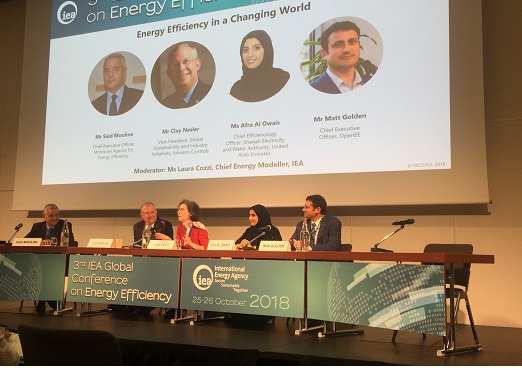Thursday 8 November 2018
At the recent IEA Energy Efficiency Conference EnergyPro contributed to a side meeting The Role of Energy Efficiency in Europe’s Flexibility Agenda. The session was designed to discuss new business models and technologies that enable efficiency to contribute to flexibility. In particular we, along with Matt Golden, focused on OpenEE which enables utilities, network operators and programme managers to meter the effect of energy efficiency in time and location. This technology is now being applied in a growing number of US states to measure and value the impact of energy efficiency programmes and enable pay for performance programmes, where payment is directly related to energy savings rather than based on capital spent or deemed savings.
There is much talk about the barriers to fully utilising the massive potential for cost-effective energy efficiency but a fundamental problem is that there is no market for energy efficiency, only various diverse markets for stuff that we hope save energy. Functioning markets need standardised units, standardised contracts, known risks and liquidity – and energy efficiency traditionally has none of these. OpenEE provides the standardised units through its open source calculations – it is a weights and measures system for energy efficiency. Once you can measure and reward the effect of energy efficiency measures you can enable any technology and target programmes more effectively. Everyone know that the electricity market is changing rapidly, as diverse and distributed energy sources increase the need for flexibility will increase even further and OpenEE enables network operators to treat energy efficiency like any other distributed energy resource.
With the rapid changes in energy markets and technologies our traditional views of energy efficiency have to change, if they don’t we will still be lamenting the under-utilised cost-effective energy resource in another forty years as we have done for the last forty years. This means energy efficiency should be treated like other energy sources and be allowed to compete on a level playing field in a functioning market. This means energy efficiency will have different values in different places and different times. It means developers need to recognise and capture the various sources of value at different levels; host and distribution system. It means developers will need to use more standardised ways of developing and documenting projects. It means we will have to use standard contracts like PPAs to buy negawatt hours and PPAs are financable instruments, this will open up new ways of financing efficiency.
It is time to build a functioning market for energy efficiency.
The programme for the event can be found here.

Comments
There is 1 comment on “Let’s build a market for energy efficiency”:
Dr Steven Fawkes
Welcome to my blog on energy efficiency and energy efficiency financing. The first question people ask is why my blog is called 'only eleven percent' - the answer is here. I look forward to engaging with you!
Tag cloud
Black & Veatch Building technologies Caludie Haignere China Climate co-benefits David Cameron E.On EDF EDF Pulse awards Emissions Energy Energy Bill Energy Efficiency Energy Efficiency Mission energy security Environment Europe FERC Finance Fusion Government Henri Proglio innovation Innovation Gateway investment in energy Investor Confidence Project Investors Jevons paradox M&V Management net zero new technology NorthWestern Energy Stakeholders Nuclear Prime Minister RBS renewables Research survey Technology uk energy policy US USA Wind farmsMy latest entries
- Ethical AI: or ‘Open the Pod Bay Doors HAL’
- ‘This is not the end. It is not even the beginning of the end. But it is, perhaps, the end of the beginning’
- You ain’t seen nothing yet
- Are energy engineers fighting the last war?
- Book review: ‘Stellar’ by James Arbib and Tony Seba
- Oh no – not the barriers again
- Don’t assume ignorance, sloth, bias or stupidity



This approach will fail. The energy savings is simply too small. Data showing programs were lying about savings to get to “cost effectiveness” thresholds abound.
Most of the value of Home Performance is very specific to the individual homeowner. Often arbitrary or unpriceable.
No smart consumer says “hell yeah, I want to spend $20,000 on my home to save $25 a month!”
They will spend it to make rooms useable, or to avoid mold, or to reduce ER visits by their asthmatic children.